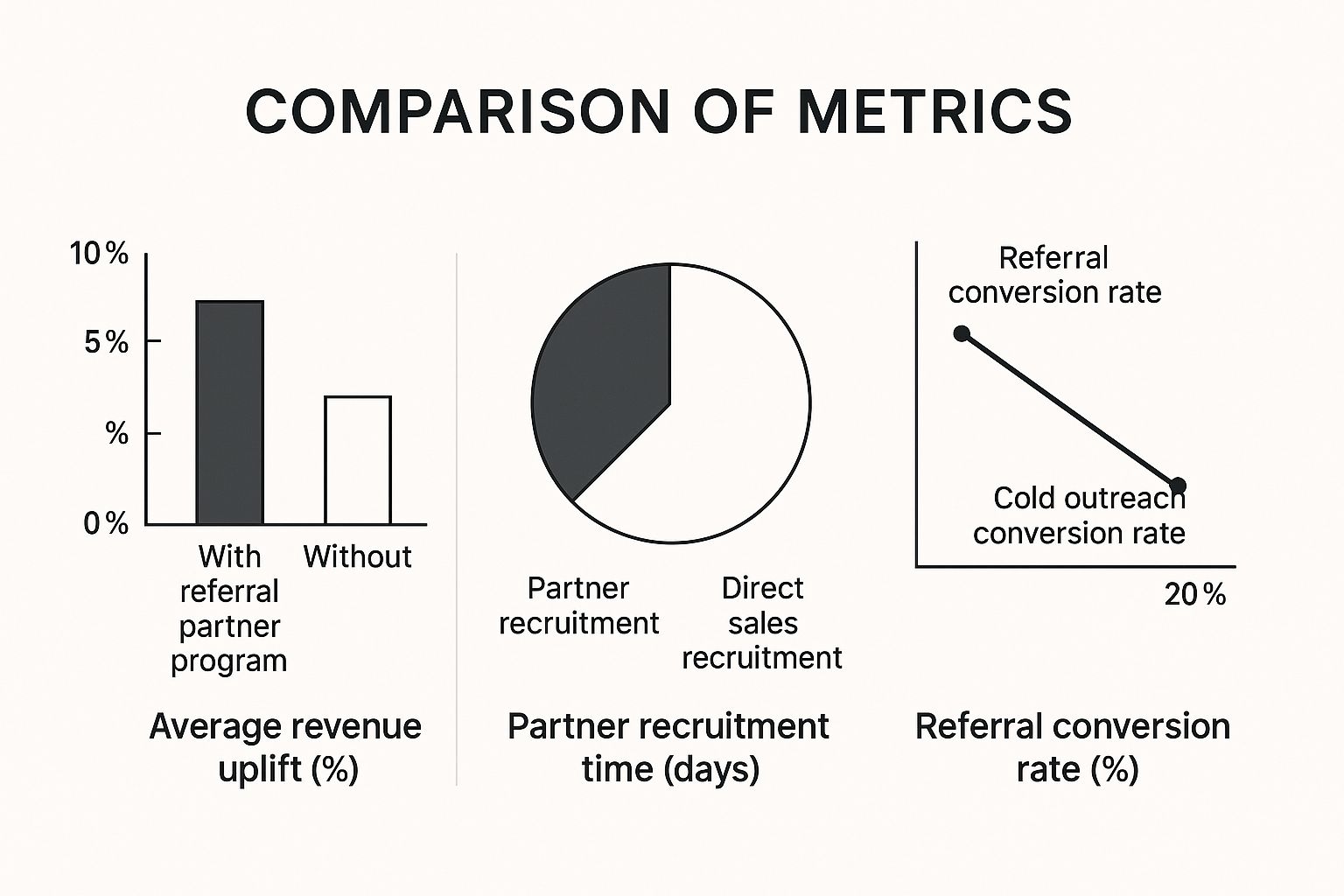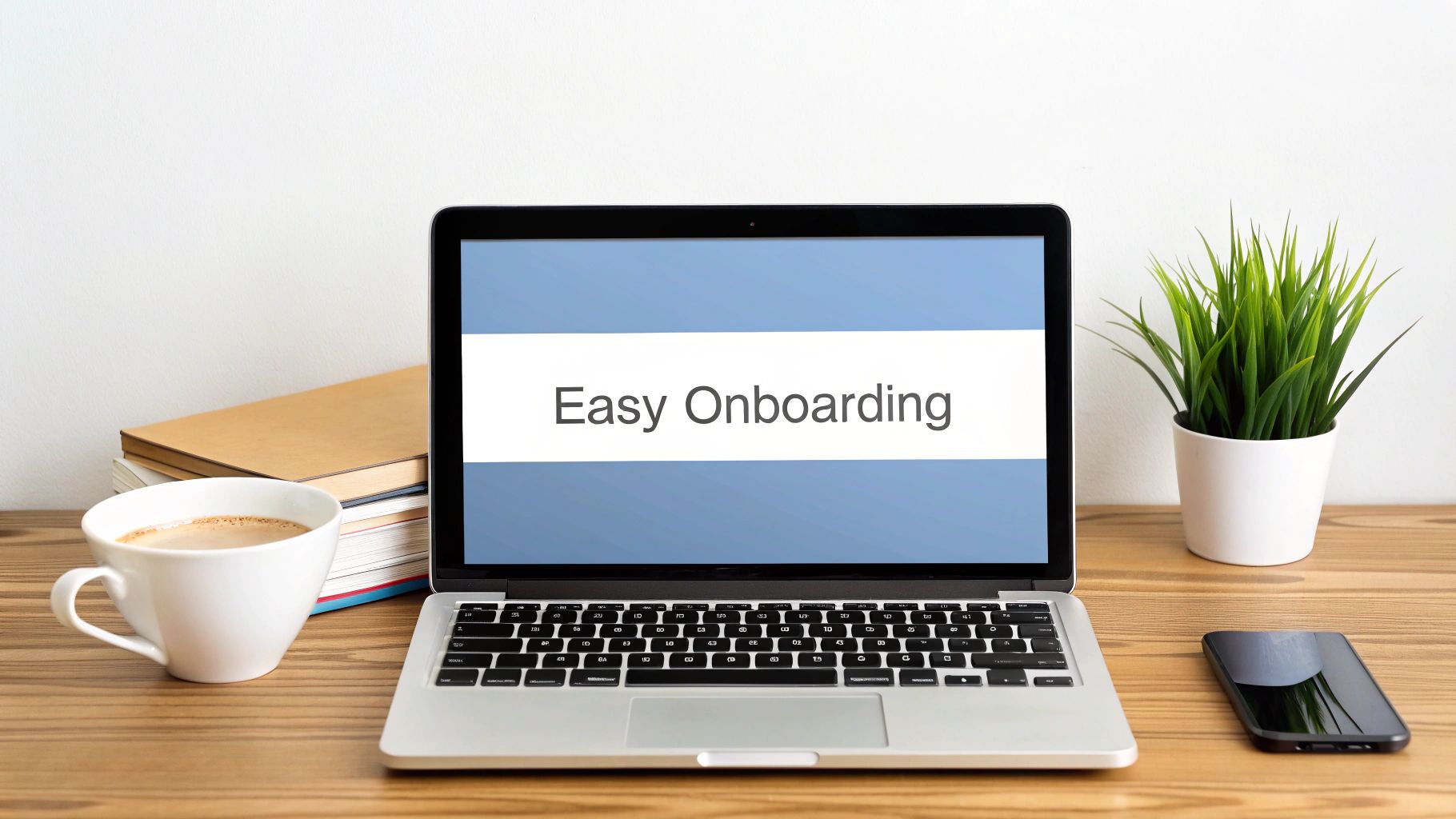Let's face it—customer acquisition costs are getting out of hand. If you're feeling the pressure to find a more scalable way to grow, you're not alone. This is where a referral partner program can be a total game-changer. It's not just another marketing tactic; it's a powerful sales channel built on the one thing that can't be bought: trust.
A good program turns that organic, hard-to-measure word-of-mouth into a predictable engine for growth.
Your Next Big Growth Channel? Look to Your Partners
In a world where everyone is shouting to be heard, a warm recommendation from a trusted source cuts right through the clutter. A formal referral partner program takes those powerful, one-off recommendations and systematizes them. You're essentially turning consultants, agencies, and even your most enthusiastic customers into a motivated extension of your sales team.
The entire strategy is built on trust, which is precisely why it works so well. This infographic lays out the stark differences between a formal program and traditional outreach.

The numbers don't lie. Referral programs don't just bring in higher-converting leads; they also speed up the entire cycle, from finding partners to bringing in new revenue.
Finding the Right Partnership Model
Before you jump in, it's crucial to understand the different flavors of partnerships. Each one attracts a different type of partner and serves a unique purpose. Getting this right from the start will save you a lot of headaches down the road.
Let's break down the main types.
Partnership Model Comparison
This table compares the three most common models to help you decide which path makes the most sense for your business.
| Model | Primary Role | Relationship | Typical Compensation |
|---|---|---|---|
| Referral | Makes warm introductions and passes qualified leads. | Less formal; focused on introducing potential customers. | One-time fee for a qualified lead or a percentage of the first payment. |
| Affiliate | Promotes to a broad audience via content (blogs, videos, etc.). | Performance-based; driven by traffic and conversions. | Recurring percentage commission on sales generated through a unique link. |
| Reseller | Directly sells and often bundles your product with their own services. | Highly integrated; acts as a direct sales extension. | A significant discount on the product, allowing them to profit on the margin. |
Choosing the right model is a foundational step. If you're still weighing the options, our in-depth guide on building a referral program can provide more clarity on which structure best fits your specific goals.
The Real Power of Scalable Trust
At its heart, a referral program is all about scaling trust. Time and again, data shows just how incredibly potent word-of-mouth is. Research from giants like McKinsey and Nielsen confirms that it can drive more than double the sales of paid advertising. In fact, a staggering 92% of consumers trust recommendations from people they know above all other forms of marketing.
A well-designed referral program doesn't just find you new customers; it finds you better customers. These referred customers typically have a higher lifetime value (LTV) and lower churn because they come in the door with trust already established.
This isn't just a tech industry phenomenon, either. It's effective across the board. For example, the dog training services market is an industry that thrives almost entirely on word-of-mouth. By putting a system behind those recommendations, you're creating a sustainable and cost-effective way to acquire customers that grows right alongside your business.
Designing a Program Partners Genuinely Value

A successful referral program really boils down to one simple thing: making it truly valuable for your partners. If they can’t see a clear win for themselves, they simply won't have the motivation to send high-quality leads your way. This is where you need to get strategic and move past a one-size-fits-all mindset to build something that feels both fair and genuinely rewarding.
The heart of that value proposition is your incentive model. A standard commission is a perfectly fine place to start, but if you really want to attract top-tier partners and see standout results, you’ll need to get a bit more creative.
Beyond the Basic Commission
Sure, standard payouts get the job done. But if you want to light a fire under your partners, tiered and creative structures are the way to go. Think about building a model that doesn’t just reward the initial referral, but also recognizes partner loyalty and consistent performance over time.
Here are a few ideas I've seen work incredibly well:
- Tiered Commissions: Don't just set one rate and forget it. Start partners at a solid base, maybe 20%, and then bump them up as they hit key milestones. For instance, after they bring in five paying customers, their commission could jump to 25%. It's a powerful motivator.
- Recurring Revenue Share: This is the gold standard for subscription-based SaaS. Offering a recurring commission—say, 15% for the first year of the customer's subscription—is a massive draw. It gives partners a predictable income stream and directly ties their success to customer retention.
- Performance Bonuses: Sometimes a quick cash injection works wonders. Offer one-time bonuses for hitting specific goals, like referring ten qualified leads in a month or helping to close a big enterprise account.
The best referral programs I’ve seen always mix financial rewards with perks that don't cost a fortune. Ask yourself: what can you offer that has high value for them but low cost for you?
For example, giving partners exclusive access to beta features creates a sense of insider status. Co-marketing opportunities, like hosting a joint webinar, give them exposure to your audience. Even providing a dedicated partner manager can make your program feel far more personal and appealing than a competitor's, even if their commission rate is slightly higher. These touches are what turn a transactional relationship into a real partnership.
Crafting a Clear Partner Agreement
Nothing kills a good partnership faster than ambiguity. A crystal-clear, concise partner agreement isn't just a nice-to-have; it's absolutely essential. This document shouldn't be a 50-page legal epic. It needs to be an easy-to-read guide that sets expectations right from the get-go.
To avoid future headaches and build a foundation of trust, your agreement needs to spell out the essentials in plain English.
Key Elements of a Strong Partner Agreement
| Element | Description |
|---|---|
| Commission Structure | Detail exactly how and when partners get paid. Include the rates, the payout schedule (e.g., Net 30), and any minimum payout thresholds. |
| Referral Qualification | Define what a "qualified referral" actually means. Is it when someone requests a demo, signs up for a trial, or becomes a paying customer? Be specific. |
| Cookie Duration | State the tracking window (e.g., 90 days). This tells partners how long they have after a prospect clicks their link to get credit for the sale. |
| Rules of Engagement | Lay out the ground rules. This should cover your brand guidelines, any restrictions on bidding on your branded keywords in paid ads, and content policies. |
At the end of the day, a solid agreement and a great incentive structure are all about building relationships. The long-term success of your program depends on keeping your partners happy and invested. It's worth exploring proven strategies to retain clients, because many of those same principles of loyalty and value apply directly to keeping your partners engaged for the long haul.
Choosing the Right Tech for Your Program

If you're thinking about managing your referral program with a spreadsheet, I'll save you the headache: don't do it. I've seen countless companies try to go this route, and it always ends in frustration, mistakes, and lost opportunities. Once you have more than a handful of partners, manual tracking becomes a nightmare.
Investing in dedicated partner software isn't just a "nice-to-have." It’s the bedrock of a professional, scalable program that partners will actually want to join. Good technology moves you from guesswork to data-driven management, ensuring every click is tracked and every commission is paid on time. That's how you build trust and prove the program's ROI.
Core Features You Cannot Overlook
When you start shopping around for referral marketing software, it's easy to get distracted by shiny features you'll never use. Let's cut through the noise. A solid platform needs to nail the fundamentals and act as the operational backbone for your entire strategy.
Here are the absolute non-negotiables:
- Unique Tracking Links: This is the most basic requirement. Every partner needs their own unique referral link or code. Without it, you have no reliable way to attribute new customers and pay the right people.
- A Real-Time Partner Dashboard: Partners shouldn't have to email you to ask how they're doing. A self-service portal where they can see their clicks, conversions, and pending commissions in real-time is essential for keeping them engaged and motivated.
- Automated Reward Fulfillment: Manually calculating and sending payouts is incredibly tedious and a recipe for error. Find a tool that automates this process based on the rules you set, whether it's through PayPal, direct deposit, or another method.
Choosing your tech stack isn't just an IT decision; it's a strategic one. The right software empowers your partners, saves you countless administrative hours, and provides the data needed to optimize and scale your referral partner program effectively.
This isn't just my opinion. The global referral marketing software market is on track to hit $7.24 billion by 2031. Automation is the new standard. And when you consider that 60% of referrals worldwide come from brand partnerships, having a robust system to manage them becomes a clear competitive advantage. If you want to dive deeper, you can explore more data on how partnerships fuel growth and see why this is a massive trend.
Evaluating Platforms for Your Stage
What works for a huge enterprise will be total overkill for a startup. Your choice of software should be firmly grounded in your company's current reality—your budget, your team's technical skills, and where you are on your growth journey.
Here’s a simple framework I use to guide companies through this decision.
Early-Stage Startups (Low Budget, High Agility)
At this stage, your focus should be on core functionality and cost-effectiveness. You need something that just works, without a steep learning curve or a scary price tag.
- What to Look For: Stick to plug-and-play solutions with simple, transparent pricing.
- Integration Needs: Prioritize tools that connect easily with what you already use, like your payment gateway (Stripe) or email platform. An embeddable solution like Refgrow can be a great fit, as it keeps the partner experience feeling native to your app.
- Expert Tip: Steer clear of platforms that demand big setup fees or lock you into long-term contracts. You need the freedom to pivot as your business evolves.
Growth-Stage Companies (Scaling, Deeper Integration)
Once you're scaling, your needs become more sophisticated. You'll want to connect referral data to your central customer database to get a complete picture of your acquisition channels.
- What to Look For: Prioritize advanced analytics, customization options, and deep CRM integration with platforms like HubSpot or Salesforce.
- Integration Needs: A robust API and webhook capabilities are key here. This lets you build custom workflows and tightly weave the referral platform into your entire tech stack.
- Expert Tip: Your partners are likely more diverse now, so make sure the software can handle more complex commission structures, like tiered rewards for top performers or multi-touch attribution models.
Recruiting and Onboarding Your First Partners
You can have the most brilliant program design in the world, but it’s just a blueprint. The real success of your referral partner program comes down to the quality and motivation of the people who are actually out there promoting your SaaS. It’s all about a smart, deliberate approach to finding and activating the right partners—which means going way beyond just a blast email to your current customer list.
Sure, your happiest customers are a fantastic place to start. But the partners who truly move the needle often come from proactive recruitment. Think about it: consultants, agencies, and even influential content creators already have the trust of audiences that perfectly match your ideal customer. Your job is to tap into that.
Finding Your Ideal Partners
First things first, you need to know who you're looking for. Take a moment to sketch out your ideal partner profile. Who has the ear of your target market? Maybe it's a marketing agency whose clients constantly need your type of software. Or perhaps it's a well-respected blogger who reviews tools in your niche.
Once you have a clear picture, it's time to go hunting.
- Social Listening: Keep an eye on hashtags and conversations on platforms like LinkedIn and Twitter. Who are the key voices already discussing the problems your product solves? Those are your people.
- Competitor Analysis: A little friendly recon can go a long way. See who’s partnering with your competitors. This is a massive shortcut—it tells you they're already open to partnerships and get the value proposition.
- Marketplace Exploration: Dive into software marketplaces and directories relevant to your industry. The agencies and creators listed there are often actively looking for great new solutions to recommend.
When you reach out, make your pitch sharp and all about them. Don't lead with what you want. Lead with what's in it for them—a new revenue stream, more value for their clients, or a chance for co-marketing exposure.
A Seamless Onboarding Experience
You’ve convinced someone to join. Great! Now, the clock is ticking. The first 30 days are absolutely critical. A clunky, confusing, or slow onboarding experience will drain all their initial excitement before they make a single referral. Your mission is to make it dead simple for them to get started and see results fast.
This is where a solid welcome kit comes in. And I don’t just mean a quick email with a login link. I mean a comprehensive resource hub built to get them up and running on day one. If you want to dive deeper into outreach, our guide on how to recruit affiliates has some great strategies.
Your Partner Welcome Kit Checklist
Think of your welcome kit as the ultimate one-stop shop. It should anticipate their questions and give them everything they need, eliminating friction and empowering them from the get-go.
Essential Welcome Kit Components
| Component | Purpose |
|---|---|
| Personal Welcome Video | A short, genuine video from your founder or partner manager makes the relationship feel personal, not transactional. |
| Program One-Pager | A scannable cheat sheet covering commission rates, payout schedules, and the basic rules of the road. No fluff. |
| Marketing Assets | A folder of pre-approved logos, banners, email templates, and social media posts. This removes the creative guesswork. |
| Product Talking Points | A simple doc with key features, benefits, and the ideal customer profile. This ensures everyone stays on-message. |
Putting in this effort upfront pays off massively. It's how you turn an interested partner into an activated, confident advocate who is truly equipped to start bringing in valuable new business.
Tracking Metrics That Actually Drive Growth

A successful referral partner program runs on data, not guesswork. It’s easy to get excited about every new partner sign-up, but if you're not careful, you'll end up celebrating vanity metrics that don't actually move the needle.
To build a program that genuinely contributes to your bottom line, you have to look past the surface-level numbers. The real story is in the data that shows the health of your referral funnel, from a partner's first share to a new customer's final payment. This is how you manage a program by the numbers and turn it into a predictable growth engine.
Moving Beyond Vanity Metrics
The first mindset shift is learning to distinguish between activity and results. A partner sharing their link a hundred times is nice, but it's ultimately meaningless if none of those clicks ever turn into paying customers. Your focus needs to be on the metrics that directly tie partner efforts to new revenue.
Think of these as your program's vital signs:
- Partner Activation Rate: What percentage of your enrolled partners are actually doing something, like sharing their link or referring their first lead? A low activation rate is a huge red flag, often pointing to a confusing onboarding process or a lack of motivation.
- Referral Conversion Rate: This is the big one—the percentage of referred leads who become paying customers. It's a direct measure of the quality of referrals your partners are sending and a core indicator of your program's health.
- Revenue from Referrals: This is the ultimate bottom-line metric. Tracking the total revenue generated by your program is how you prove its value and justify putting more resources behind it.
The most effective programs I've seen are almost obsessive about tracking the entire referral journey. They don't just ask, "How many leads did we get?" They ask, "Which partners sent the highest-quality leads, and why?"
This data-driven approach lets you double down on what’s working. For example, if you see that partners who finish your onboarding course have a 50% higher referral conversion rate, you know that investing in better training will deliver a tangible return.
The True Value of a Referred Customer
It’s a lesson I’ve learned over and over: not all customers are created equal. Customers who find you through your referral program are often your absolute best. They show up with a built-in layer of trust, thanks to the partner's recommendation, and this has a massive impact on their long-term behavior.
The data consistently supports this. Referred customers typically have a 37% higher retention rate and an 18% lower churn rate than customers acquired from other channels. Even better, they tend to spend 25% more on average, making them far more profitable over their lifetime.
This is where tracking the Customer Lifetime Value (LTV) of referred customers versus non-referred customers becomes critical. When you can walk into a meeting and show that a partner-sourced customer is worth 1.5x more to the business, the entire conversation about your program's value changes.
To get a clear picture of what you should be tracking, it's helpful to look at a few key performance indicators side-by-side with industry benchmarks.
Key Referral Program Performance Metrics
| Metric | What It Measures | SaaS Industry Benchmark |
|---|---|---|
| Partner Activation Rate | % of partners who share their link or refer a lead. | 20-30% |
| Referral Conversion Rate | % of referred leads who become paying customers. | 5-10% |
| Referral Share Rate | % of active partners who share their link per month. | 15-25% |
| Customer LTV (Referred) | The total revenue a referred customer generates. | 25%+ higher than non-referred |
| Program ROI | Total program revenue divided by total program costs. | 3:1 or higher |
Tracking these numbers gives you a dashboard for your program's health. For a deeper dive into the numbers that matter most, check out our complete guide to essential referral program metrics.
Got Questions About Your Referral Program? We've Got Answers
Even with the best-laid plans, you're going to have questions as you get your referral program off the ground. That's just part of the process. Thinking through these common sticking points ahead of time will save you headaches later and keep your program running smoothly.
Let's dive into some of the most frequent questions we hear from SaaS founders. Getting these right builds the trust that’s so essential for any strong partnership.
What’s a Fair Commission Rate to Start With?
This is the big one, and the honest answer is, "it depends." But I won't leave you hanging. For most SaaS companies, a good starting point is somewhere between 15% and 30% of the first payment or the first year's contract value.
But please, don't just pull a number out of a hat. You need to weigh a few key factors:
- Your Customer Lifetime Value (LTV): The higher your LTV, the more room you have to be generous with commissions. It's simple math.
- Your Customer Acquisition Cost (CAC): Your referral commission has to be more efficient than your other marketing channels. If it's not, what's the point? Make sure it's sustainably lower than your average CAC.
- What Competitors Are Offering: Do a little digging. If your main competitor is offering a 25% recurring commission and you come to the table with a one-time 10% offer, you’re not going to attract the best partners.
My advice? Start with a competitive but sustainable rate. Something like 20% recurring for the first 12 months is a fantastic sweet spot. It's attractive enough to get quality partners on board and aligns their incentives with yours—they only make money if the customer sticks around. Win-win.
Remember, you can always get more creative later. Introducing performance-based tiers or special bonuses for your top performers is a great way to reward them without overspending on partners who haven't proven themselves yet.
How Should We Handle Partner Disputes?
Disputes are rare, but they do happen. Almost every time, it's about a partner who believes they weren't credited for a sale they sent your way. This is where having clear, pre-defined rules and the right software saves the day.
Your partner agreement is your first line of defense. It needs to spell out your attribution model—for example, "last click wins"—and the cookie life, like 90 days. When a disagreement pops up, you can simply point to the terms and show them the data from your referral tracking platform.
Transparency is your best friend here. If you can, share the tracking data with the partner to show the customer's journey. If the situation is a bit of a gray area or involves a truly valuable partner, sometimes making a one-time goodwill payment is a small price to pay to maintain a crucial relationship.
How Long Does It Take to See Results?
This is all about managing expectations—both yours and your team's. A referral program is a long-term play, not an overnight growth hack. It takes time to find and recruit the right partners, get them up to speed, and for their efforts to translate into actual leads.
You can probably expect to see the first few referrals trickle in within the first 30-60 days as you onboard your initial cohort. But to see a steady, predictable stream of business? That usually takes closer to 3-6 months. Be patient. Focus on building real relationships with those first partners. The effort you put in now will pay off massively down the road.
Ready to stop managing partnerships with spreadsheets? Refgrow provides an embeddable, fully native referral dashboard for your SaaS with just one line of code. Launch, track, and scale your program in minutes. Get started with Refgrow today!

